As much as I like playing heavy games, I have to admit I groan inwardly every time I open a box and am faced with 20-30 pages of rules. It’s not the amount of pages I mind, it’s more that feeling of “is this really necessary”? It seems that nowadays more and more games create depth and complexity but adding layers of rules, exemptions, and an accompanying plethora of components to the box.
Iwari, an iteration of Michael Schacht’s Web of Power / Han / China system, doesn’t really qualify as heavy gaming. But it’s a nice illustration how one can achieve a lot of game with rather few rules.
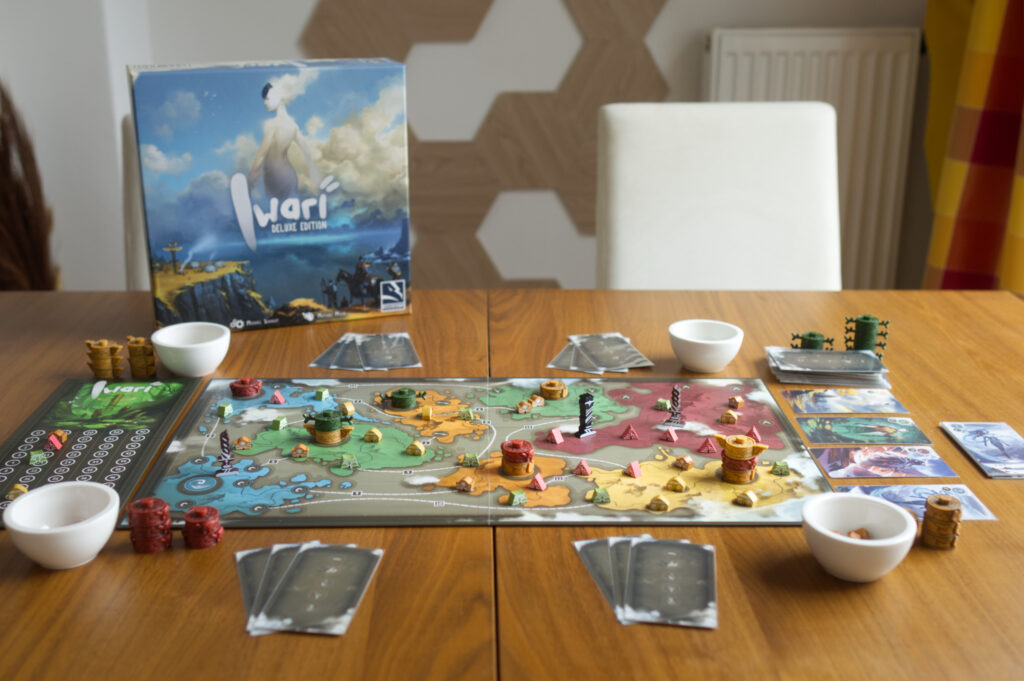
Setup
Setting Iwari up is as simple as can be: chose one of the sides of the double-sided main board, close off a few of the connections based on player count, hand each player their tent and totem pieces, shuffle the deck of gorgeous but maybe a little over the top illustrated biome cards, and give each player their starting hand. That’s pretty much it. Okay, to be fair, some suits of cards will have to be removed based on player count, but that’s quickly done. This is a game system that originally came out all the way back in the year 2000, and it shows in how straight forward setup is. There are no variable elements on the board, no tokens to seed.
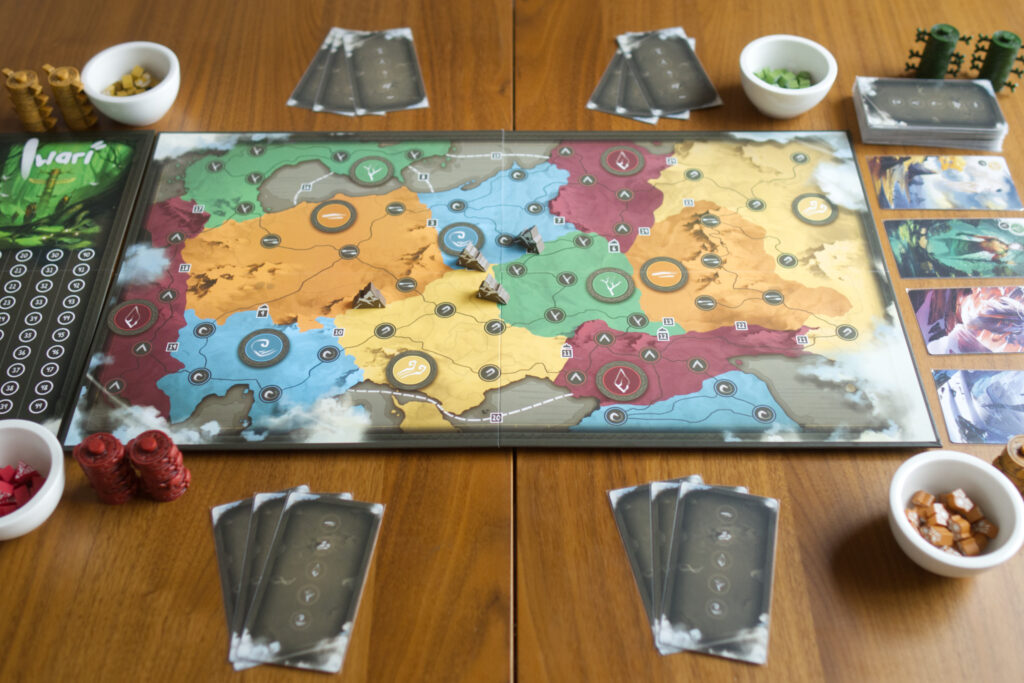
The Turn
On a player’s turn, they can play up to three cards from their hand to place up to two pieces on the board in a single region, also known as the 3-2-1 rule. The color of the cards prescribe in which region the piece can be placed, with two cards of the same suite acting as a wild.
The pieces to be placed can be any combination of tents and totems as long as they follow some basic rules. Tents have to be placed in an empty spot in a region, with some slight incentives to build connected lines of tents for bonus end game scoring. The main aim though is to gain majority in a region. When the deck of cards runs out, the player with the majority of tents in a region gets points equal to the total number of tents by all players in that region. The player with the second most tents gets points equal to the number of tents owned by the first player, the third by the second, and so on. To avoid a single player opening up a new region and immediately having a giant head start, the first player to place a tent in a new region can only place a single tent.
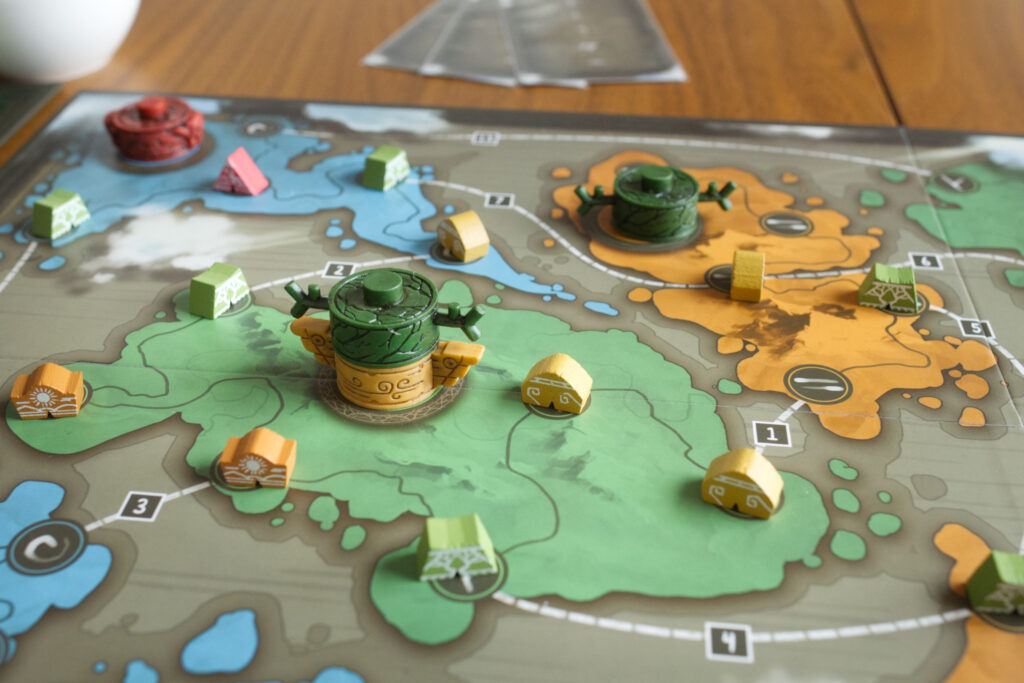
So far, so boring. Pick cards from the market display to be able to place tents into regions where you might achieve majority and of course try to place two tents in one go. Where things get interesting is the linking of tents in a region to the totems. Instead of placing a tent, a player can choose to place one of their totem pieces into the same region. However, the number of totem pieces that can exist is limited by however many tents the leading majority is. Let’s say there are three red, one blue, and one orange tent in a region. That results in a maximum of three totem pieces being allowed. Want to place a fourth one? Better hope the red player places another tent and doesn’t also place a totem in the same turn. Totem pieces however are limited, so one can’t just dump them without care.
The turn ends by drawing back up to three cards, either from the open display or from the dop of the deck. That’s it. 3-2-1, draw cards, next player.
Game End
So what are totems for? Once the deck has run out, the discard is reshuffled and players go through the deck a second time. After that, tents are again scored, but now in addition are the totems. Between regions of the board, there are printed numbered connections. For each of those, it is now checked if the same player has the majority of totem pieces in both of them. If so, they gain one point for each totem piece—independent of player—in both regions. That can amount to quite a bit of points, especially in regions with much competition and if one manages to score the same totems more than once.
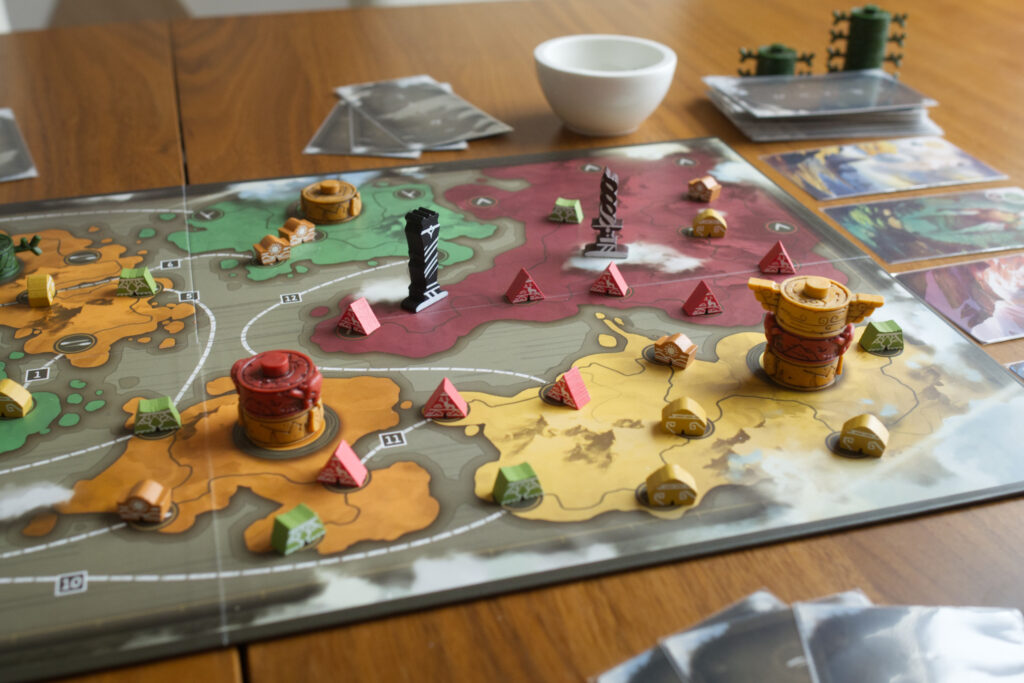
Finally, connected lines of tents of the same colour are awarded one point for each tent in it. Player with the most points wins. All of that doesn’t sound like much, but it creates quite the clever little pressure cooker. Should you go for tent majorities and score twice or totems which potentially can be worth a lot of points? Should you open a new region or will this just create too much of an opportunity for other players? Fight for a majority in a particular region or not over-invest your forces? Each tent you place might open up new possibilities for the next player.
To spice things a bit more up and adapt to modern tastes, Iwari introduces “feats” which were not a part of Web of Power. They are 6 wooden tokens that can be placed in a region or on a connection if a player during the course of the game achieves a certain condition, like building the first settlement in the game. Based on type, they either add a multiplier to the tent or totem scoring of that region/connection. They are a nice way to make certain regions more attractive while annoyingly of course attracting other players. I didn’t have the feeling though that they added anything essential to the mix that couldn’t be left out.
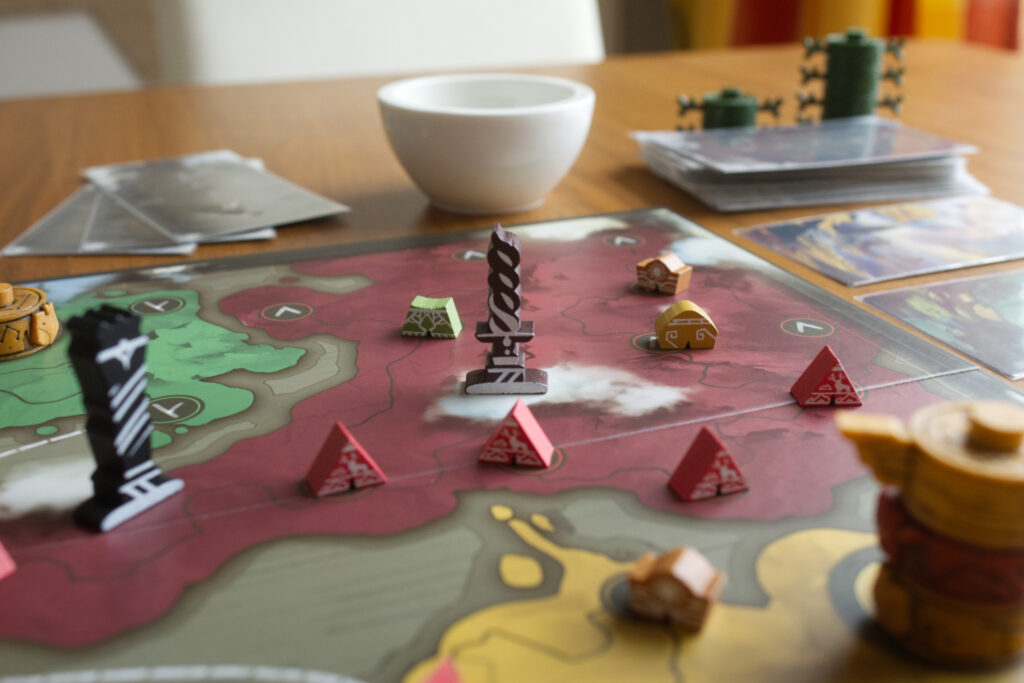
Normal vs Deluxe Edition
Web of Power was a rather plain looking game where Iwari started out as a blinged out Kickstarter project that later came to retail. As a result, it has some pre-shaded totem miniatures whereas the tents are wooden. Both the art on the cards as well as on the board can best be described as looking good but as if someone pulled the contrast slider a bit too high up. Things don’t really gel that well together. I much more preferred the theme of monasteries and advisors in medieval Europe to this nature spirit mash up with what looks like Native American cultural appropriation. But at least it pushed the production values more into the 2020s. Web of Power was basically just a bunch of wooden houses and cylinders.
The photos you see in this text are from the Deluxe Edition, which has screen printed meeples where the retail version has plain ones, wooden mountains to block of connections where the retail edition uses cardboard, etc. The two most important changes—and reason why I would strongly recommend picking up the Deluxe Edition if any—are the inclusion of six more maps and a solo mode. But there are some other minor additions and modules as well. One thing to be aware of though: there is an issue that the yellow and orange totem pieces are awfully close colour-wise. They have different shapes, but still are easy to mix up. In the photo below, try to guess which one is supposed to be yellow and which one orange …
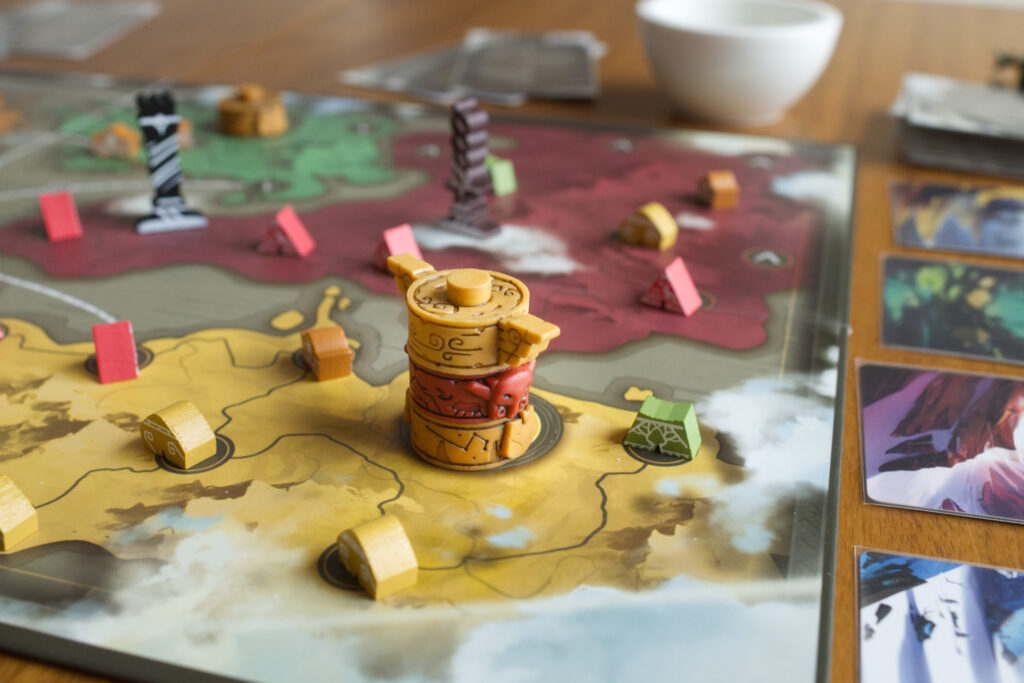
Let’s talk about the maps first. They add completely new mechanisms to the map, making certain locations more attractive or blocking things off until unlocked. There is for example the “Uncharted Paths” map that starts with 5 purple totem pieces the players can move to other regions and thus block spots on the totems. Or the “Floating Lands” where no totems can be placed on the tundra biome. I quite like the additional maps as they sprinkle in a little bit extra that can serve as motivation to get Iwari back to the table but the added rules overhead is small, just a few bullet points.
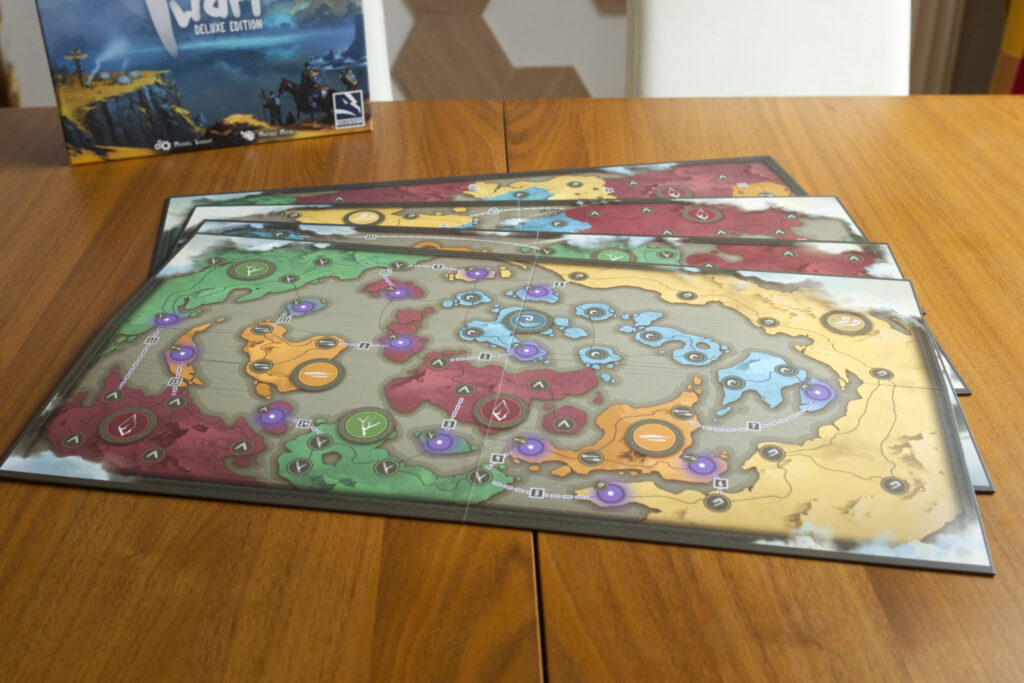
Then there are the so called “expedition cards” that add objectives and award points for the first player to achieve them. To be honest, I’ve never bothered playing with them.
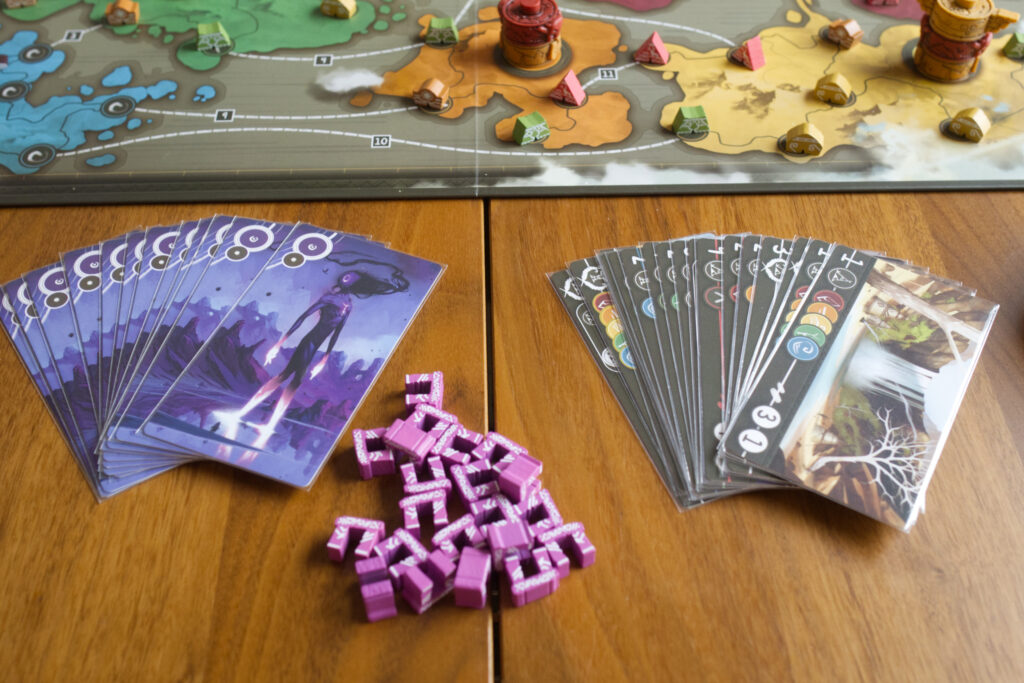
There was also a set of optional add-ons, ranging from storage bags to metal tokens for marking which connections had been scored (one of the most useless cases of metal tokens I’ve seen) and two small variants that came with metal tokens as well. I picked some up here and there over time because I like collecting such stuff, but they don’t really add much. I like having the metal totem when playing solo because it’s nicer to use that one to mark the active connection than the normal wooden cylinder. But that’s it. Still, if someone wants to send me their storm token and baggies so I can complete the set, let me know!
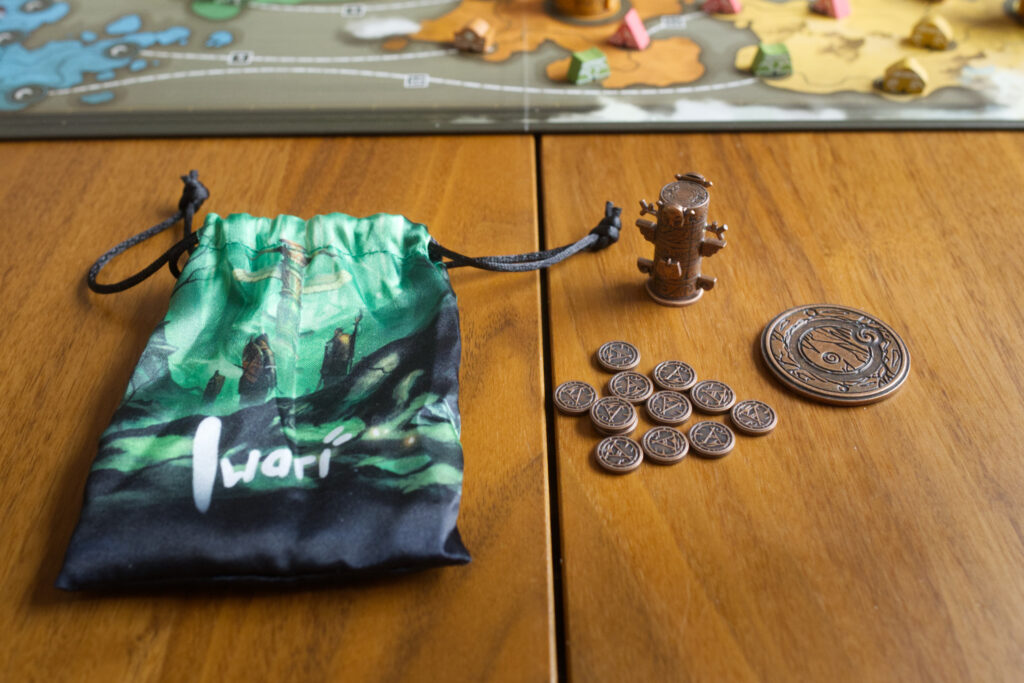
Solo Mode
As mentioned, the solo mode is unfortunately not part of the retail edition. It comes in the form of tents/totems in a purple color plus matching cards representing “the Void”. The void cards are shuffled into the deck and whenever one shows up (either by being refilled in the market or when the player plays one), the void infests regions by placing totems or tents based on the current connection (marked by a token) and then moves the indicator token to the next connection in ascending order. The human player on the other hand plays normally but uses one of his left over cards for a turn to execute a move for the void. If the player manages to use all three cards, even better, no void activity at all.
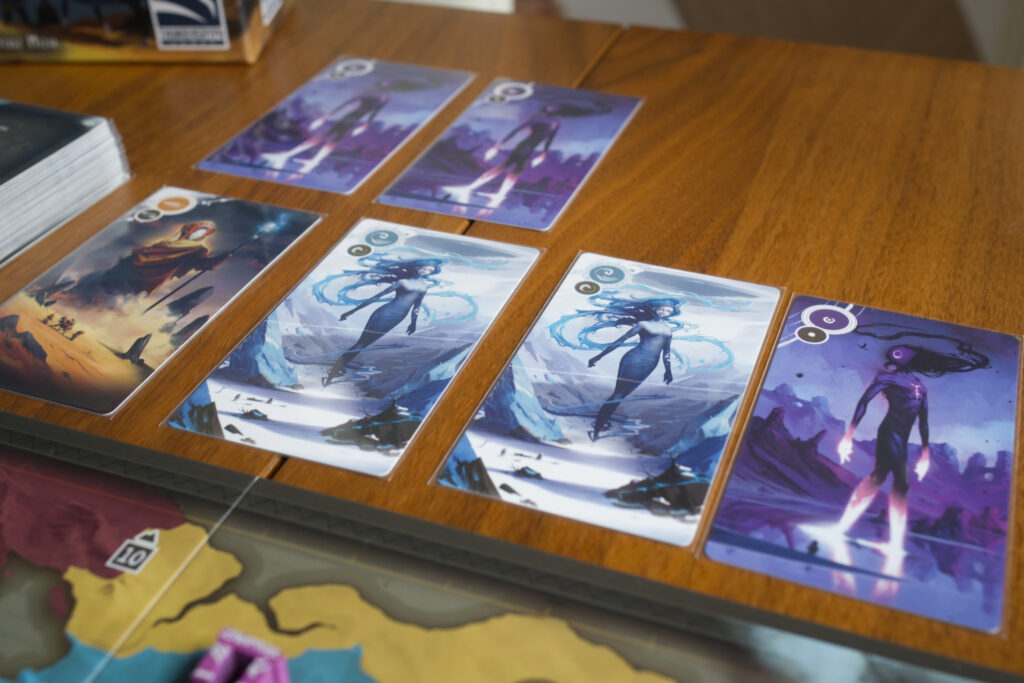
The mechanism of the void cards adds a nice inventive to draw more from the deck and pick less cards from the display. If you draw a void card on to your hand, at least you have some form of control to delay the next void infection it a bit. Once however four void cards have been played, a special corruption event happens where the void not only places new pieces but also immediate triggers scoring of the adjacent regions. Scoring in solo mode works completely different from normal game. It happens whenever the last tent space is filled in a region or a void corruption occurs. Whoever has the majority in totems in a region wins that region and marks it as corrupt or not. The player that has the majority in tents adds one “virtual totem” and the void wins all ties. If the void manages to corrupt 3 regions, the game is automatically lost. The human player wins the game if the they or the void cannot do a legal move or all regions have been scored.
It doesn’t sound like much, but it actually is quite a nice puzzle to solve. Infesting/corrupting a region happens so quickly, it feels like you have to counter the void on all fronts while managing when it will tigger an infestation or corruption. It’s not the same as multiplayer, but the feeling of constantly being under pressure and not creating openings for the other players is there. And the solo mode is compatible with all maps as special solo rules for them have been added in the rules.
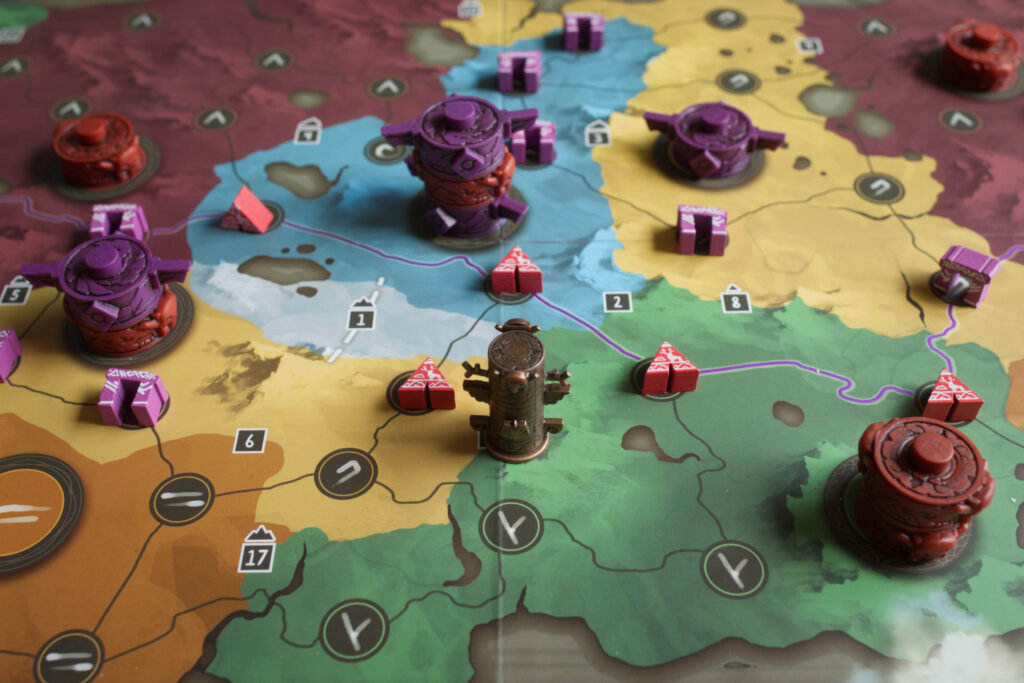
Conclusion
I liked Web of Power a lot when it originally came out. It’s so clean and nifty, the dilemma so delicious. But over time it got pushed to the side as more—let’s call it exciting—games came out. Did I prefer Castles of Burgundy over Web of Power? Sure. Agricola? Of course. Splendor? Way more addictive! There are countless examples of games I was always more excited to get to the table than Web of Power, and so it dropped out of my collection despite lots of fond memories.
But the fond memories remained. I was curious about Iwari for a long time, but only picked it up when I found a used Deluxe copy for basically half price. Having 8 maps, a co-op, 2p, and solo mode definitely is a different value proposition than having a 3-5 player game (=Web of Power) that I would rarely get to the table. As I wrote, I do enjoy the solo mode as it’s quick to get to the table but more crunchy than some other light-to-mid weight games. As a multiplayer experience, it acts as a sort of filler+ for us. Like when we are done with whatever main course we had for the evening and still have an hour to spare on some nice and clean area majority fighting. Iwari’s big selling point is the low barrier to entry: get it out, quickly set it up, and you’re good to go. The rules are simple and the dilemma yet crunchy. The nice production values and multiple maps also make it more attractive and help to get other players on board … at least if you know to avoid the retail edition.
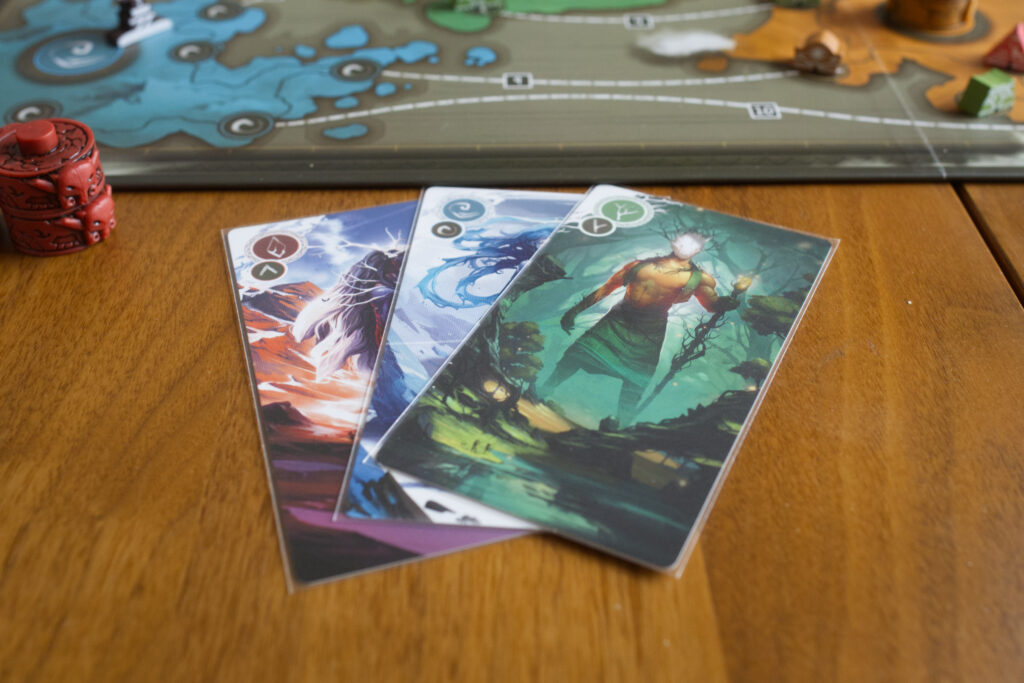
I think if the publisher had chosen a different setting / art style (nothing wrong with politics in Medieval Europe in my book) and not cut the solo mode from the retail edition, more people might be playing Iwari today. Imagine a Web of Power with minis, beautifully illustrated art, and some thematic throw in that is a little bit more substantial than the feats. As is, Iwari is just something for the aficionados of old school Hansa Teutonica-style games and a deal to be had on the second hand market. Definitely not a must buy, but if you like clever and clean area majority, you might want to give it a chance!
